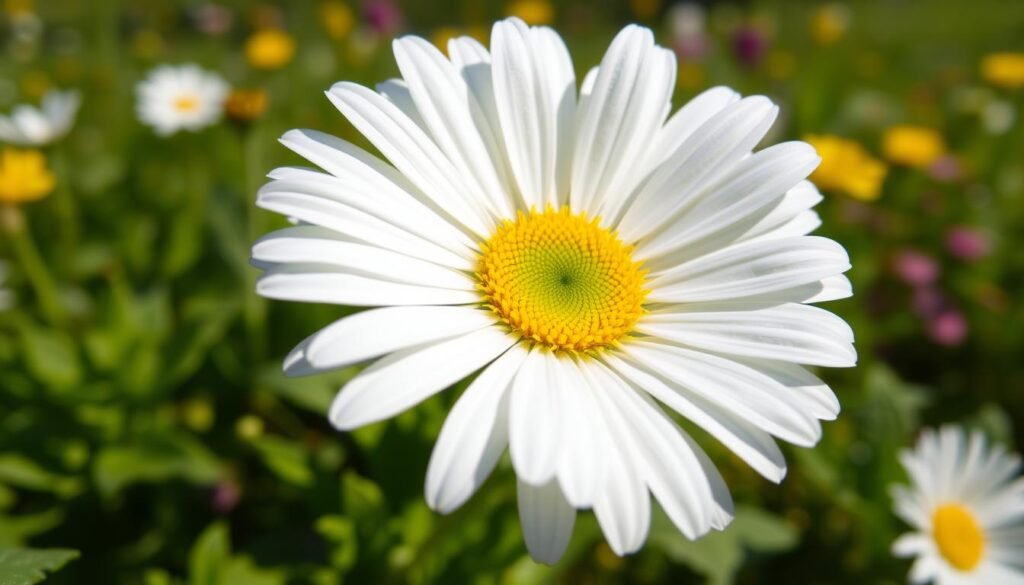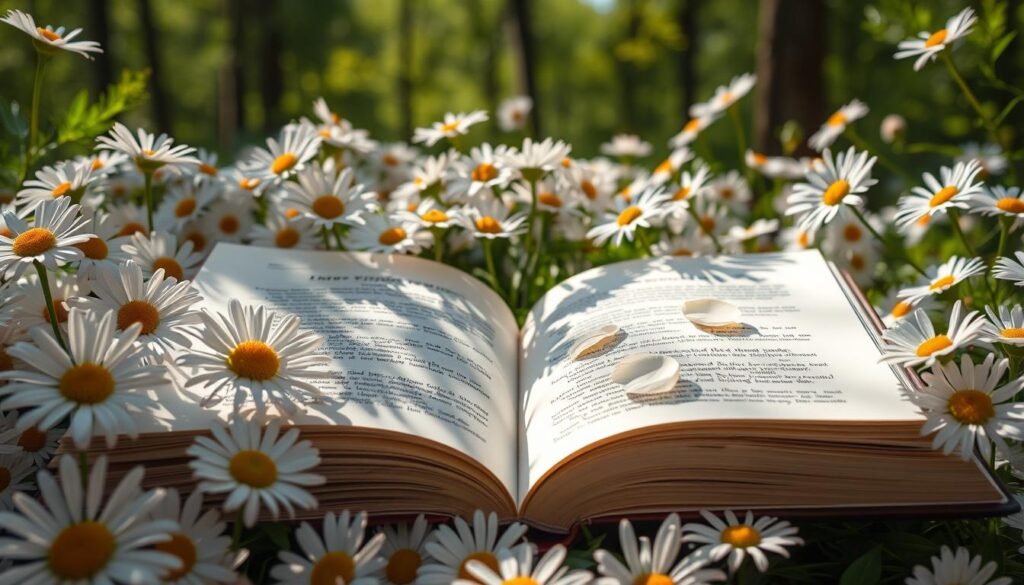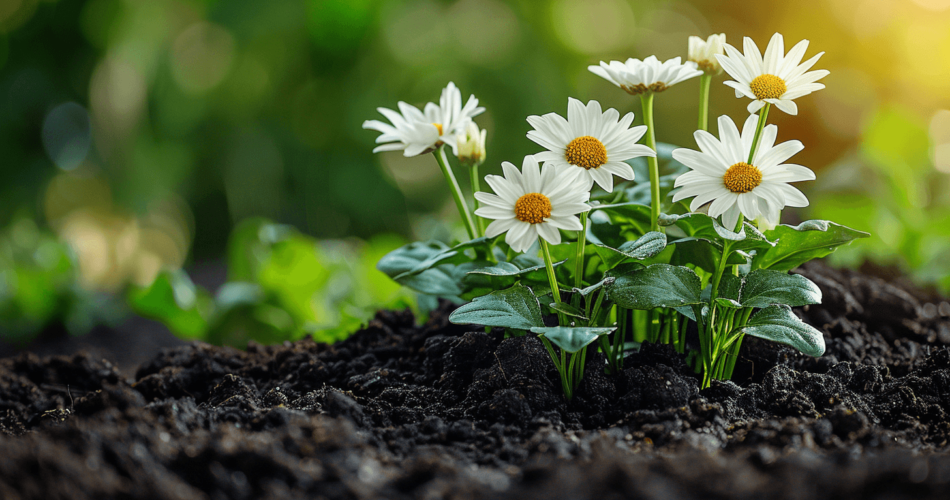Daisies are known for their fresh, happy, and innocent vibe. They come from Europe and Asia but are now found on every continent except Antarctica. The name daisy comes from “Daes eage,” meaning “day’s eye,” because they close at night and open in the morning. They are related to sunflowers and are more than just pretty. They have healing properties and can even be used as a garnish. Bees love daisies, especially Shasta daisies, because of their flat shape. This makes it easy for them to collect pollen and nectar.
Related Post: Birth Flowers for all 12 months

Key Takeaways
- Daisies are known for their symbolism of innocence, loyalty, and secrecy.
- Different daisy colors have unique meanings, from purity to love and friendship.
- Daisies have diverse origins, found in various regions across the globe.
- Daisies have been used for medicinal and edible purposes throughout history.
- Proper care is essential to prolong the life of cut daisy flowers.
What is Daisy Flower
Daisies are loved for their bright, sunny look and soft petals. They might seem like a classic American flower. But, these flowers have a rich history worldwide.
Daisies have been around since at least 2,200 BC. The ancient Egyptians grew them in their gardens. They also used daisies for medicine.
History and Origins of Daisies
The daisy family, known as Compositae, was named in 1792 by Paul Dietrich Giseke, a German botanist. The gerbera daisy, a modern favorite, was found in 1884 in South Africa by Robert Jameson, a Scottish man.
Popular Types of Daisy Flowers
There are many daisy types, like the Shasta daisy with its soft petals. The Rudbeckia, or black-eyed Susan, is known for its bright yellow color. With over 20,000 varieties, daisies are found on every continent except Antarctica.
Daisies range from the common English daisy to the vibrant gerbera. They come in many colors, shapes, and sizes. These flowers add joy and beauty to any place.
Daisy Flower Meaning and Symbolism
Daisies carry many positive meanings. The white daisy stands for purity and innocence. The yellow daisy shows friendship, joy, and happiness. Pink daisies are linked to love and feminine energy, while orange daisies bring vibrant energy and warmth.
A red daisy speaks of deep love and passion. Purple daisies symbolize thoughtfulness and peace. The rare blue daisy flowers represent trust and loyalty. Daisies are bright and sunny, making them perfect for sharing joy and celebrating.
Symbolism of Daisy Flower Colors
- White daisies symbolize purity, innocence, and loyal love.
- Yellow daisies represent friendship, joy, and cheerfulness.
- Pink daisies signify platonic love, romance, and feminine energy.
- Orange daisies symbolize vibrant energy, happiness, and warmth.
- Red daisies convey deep romantic love and passion.
- Purple daisies mean thoughtfulness, peace, and royalty.
- Blue daisies represent trust, honesty, and loyalty.
Daisies have been tied to love, purity, and luck in many stories. In Western cultures, they’re given to girls as a sign of purity. They’re also a favorite for tattoos, carrying personal meanings for many.
Fascinating Daisy Flower Facts
Daisies are more than just a common garden flower. They have a rich history and unique traits. For example, did you know a daisy is actually two flowers? The big outer petals are one, and the tiny ones in the center are another.
Another cool fact is that daisy leaves are edible and full of vitamin C. They’re related to artichokes and have been used to treat many health issues. People have used daisies for centuries to help with indigestion, coughs, and back pain.
Daisies are also very tough and can grow almost anywhere. They’ve been around since the dinosaurs roamed the earth. You can find daisies on every continent except Antarctica, showing how adaptable they are.
Whether you love gardening or just enjoy looking at daisies, they’re truly special. Their unique structure, health benefits, and long history make them stand out. Daisies are truly one-of-a-kind flowers.
| Interesting Daisy Flower Facts | Details |
|---|---|
| Dual-Flower Structure | The daisy is technically two flowers in one – the large outer petals make up one flower, while the cluster of tiny petals in the center “eye” make up another. |
| Edible Leaves | Daisy leaves are edible and high in vitamin C, closely related to the artichoke. |
| Medicinal Properties | Daisies have been used throughout history to treat a variety of ailments, from relieving indigestion to soothing coughs and easing back pain. |
| Ancient Origins | Wild daisies date back to the time of the dinosaurs, making them a hardy and adaptable species that has endured for millennia. |
| Global Presence | Daisies can be found on every continent except Antarctica, thriving in diverse climates and habitats across the globe. |
Medicinal and Edible Uses of Daisies
Daisies are not just pretty to look at. They have been used for medicine and food for a long time. In the 18th century, doctors used them to help with wounds. Even King Henry VIII used daisies for eye problems, stomach issues, gout, and fever.
Medicinal Properties of Daisies
Today, some people still use daisies for coughs, inflammation, kidney issues, and muscle pain. But, it’s wise to talk to a doctor before using them for health reasons. The common wild daisy (Bellis perennis) is the most used for medicine.
Daisies have saponins, which might help skin make more collagen. They are used for bleeding, cough, bronchitis, and wounds. But, there’s not much scientific proof, and side effects are a concern.
Are Daisies Edible?
The common English daisy is good in salads, soups, sandwiches, and even as tea or wine. It tastes spicy and nutty. Other daisies like sunflowers and chamomile are also edible. Just make sure they are grown for eating.
| Parts Used for Food | Harvest Time |
|---|---|
| Leaves, flowers, and roots | January to November |
The young flower heads or buds are great in salads, soups, or sandwiches. The leaves can be eaten raw or cooked. Daisy buds can be pickled like capers. Daisies are rich in vitamin C, with 34 mg per 100 g.

But, it’s key to remember that daisies might cause allergic reactions in some. This is because of saponins and their connection to plants like ragweed and chrysanthemums.
Mythology and Folklores Surrounding Daisies
Daisies have a special place in many cultures, filled with deep meanings. In Celtic mythology, daisies were seen as a gift from God to comfort parents who lost a child. This shows their connection to life, death, and the divine feminine.
In Norse mythology, daisies were linked to Freya, the goddess of love and fertility. An old Roman myth tells of a nymph named Belides who turned into a daisy to avoid a god’s advances. These stories add to daisies’ symbolism of love, nature, and life’s cycle.
Daisies have also been part of many cultural traditions. In medieval Europe, they symbolized the sun because of their bright yellow centers. Christianity saw daisies as symbols of the Virgin Mary, representing purity and innocence. In Old English culture, daisies stood for loyalty and trust, linked to their constant blooming.
The folklore and mythology surrounding daisies give them a rich, symbolic meaning. They are not just pretty flowers but also carry deep cultural significance.
Daisies in Language and Literature
Daisies have a special place in language and literature. Their name comes from Old English, meaning “day’s eye.” This refers to how they open at dawn and close at dusk. Phrases like “fresh as a daisy” show their bright and cheerful image.
In classic literature, daisies are often seen. They appear in poems by William Wordsworth and Lewis Carroll’s “Alice in Wonderland.” Their simple beauty stands for innocence, simplicity, and nature.
In the language of flowers, daisies symbolize loyal love, purity, and secret admirers. Over time, they’ve come to mean new beginnings, fresh starts, and a sense of wonder. Their unique structure has inspired many poetic and artistic works.
Daisies in literature and language still charm us today. They bring a timeless and universal sense of joy. Whether in a bouquet or a metaphor, their beauty is always captivating.

Tips for Caring for Cut Daisy Flowers
Daisies are great in bouquets and arrangements, but they need a little extra care. By following a few simple steps, your cut daisies can stay bright for up to two weeks.
Prolonging Vase Life of Daisies
- Carefully cut the stems at an angle to help them better absorb water.
- Remove any low-hanging leaves that will sit below the waterline in the vase.
- Fill the vase 3/4 full with fresh, cool water and add flower food if available.
- Check the water level and quality daily, changing the water and adding new food every 2 days.
- Re-cut the stems every 1-2 days to prevent wilting.
By following these tips for caring for cut daisy flowers, you can keep them fresh longer. Keeping the water fresh and re-cutting the stems are key. With a bit of extra care, you can enjoy these cheerful blooms for longer.
When to Gift Daisy Flowers
Daisies are perfect for many occasions because they bring joy and cheer. They are the birth flower of April, making them great for April birthdays. They also mark a 5th wedding anniversary. Their purity and innocence make them ideal for new babies, bridal showers, and weddings.
Daisies are known to spread happiness. A bouquet can be the perfect way to brighten someone’s day. They’re especially good when someone is feeling down or going through tough times. Daisies always bring a warm, genuine gesture.
- Daisies are the birth flower of April
- Daisies are the traditional flower for a 5th wedding anniversary
- Daisies symbolize purity, innocence, and happiness
- Daisies make thoughtful gifts for new babies, bridal showers, and weddings
- Daisies can brighten someone’s day, especially during difficult times
When you gift daisy flowers, they always bring a smile. Their timeless beauty and wide appeal make them a great choice for many daisy flower gift giving moments.
Conclusion
Daisies started in Europe and Asia and now are loved worldwide. They come in many colors and mean joy, purity, and new starts. With over 20,000 types, they brighten our lives.
Daisies have interesting stories, uses, and roles in books. They make us happy when we give them as gifts or just enjoy their beauty. They add joy to any place.
The daisy flower summary and key facts about daisies show why they’re so special. They’ve been loved for ages, from myths to today. Daisies remind us of nature’s beauty and our hopes for a better world.
FAQ
What is the origin of the name “daisy”?
The name “daisy” comes from Old English. It means “day’s eye.” This is because the flowers close at night and open in the morning.
How many varieties of daisies exist?
There are over 20,000 types of daisies worldwide. They are very diverse and versatile.
What are the symbolic meanings of different colored daisies?
White daisies stand for purity and innocence. Yellow daisies mean friendship and joy. Pink daisies show platonic love and romance.
Orange daisies symbolize vibrant energy and happiness. Red daisies express deep love and passion. Purple daisies mean thoughtfulness and peace. The rarest blue daisies represent trust and loyalty.
Do daisies have any medicinal or culinary uses?
Yes, daisies have been used for health for centuries. They can help with indigestion, coughs, and back pain.
The common English daisy is also edible. It can be used in salads, soups, and even made into tea or wine. It tastes spicy and nutty.
What are some interesting myths and folklore associated with daisies?
In Celtic mythology, daisies were believed to comfort grieving parents. In Norse mythology, they were Freya’s sacred flower.
There’s also a Roman myth. A nymph named Belides turned into a daisy to escape a god named Vertumnus.
How can I care for cut daisy flowers to make them last longer?
To care for cut daisies, cut the stems at an angle. Remove any leaves below the waterline.
Fill the vase with fresh, cool water and add flower food. Check the water daily and re-cut the stems every 1-2 days to prevent wilting.
What are some good occasions to gift daisy flowers?
Daisies are great for many occasions. They are the birth flower of April and a symbol for a 5th wedding anniversary.
They’re also perfect for new babies, bridal showers, and weddings. Or just to brighten someone’s day when they’re feeling down.
Source Links
- https://www.floraly.com.au/blogs/news/the-daisy-flower-meanings – The Daisy Flower: Meanings, Images & Insights
- https://alphafloralsb.com/blog/what-is-the-daisy-flower-meaning/ – Alpha Floral
- https://www.floraly.com.au/blogs/news/the-daisy-flower-meanings– The Daisy Flower: Meanings, Images & Insights
- https://www.plantlife.org.uk/plants-and-fungi/daisy/ – Daisy – Plantlife
- https://www.realsimple.com/types-of-daisies-flowers-8572130 – 8 Types of Daisies You Should Consider for a Colorful Garden
- https://www.floraly.com.au/blogs/news/the-daisy-flower-meaningsThe Daisy Flower: Meanings, Images & Insights
- https://www.aprilflora.com/blogs/news/about-daisy-flowers-meaning – Everything to Know About Daisy Flowers and Their Meaning
- https://rosaholics.com/blogs/rosaholics-bloggers/daisy-flower-meaning– Daisy Flower Meaning and Symbolism
- https://www.bhg.com/gardening/flowers/daisy-facts/ – 5 Fascinating Facts About Daisies That Will Make You Smile
- https://www.1800flowers.com/articles/flower-facts/all-about-daisies – Daisy Facts, History, & Symbolism | Petal Talk
- https://facts.net/nature/plants/20-astounding-facts-about-daisy/ – 20 Astounding Facts About Daisy
- https://www.eatweeds.co.uk/daisy-bellis-perennis – Daisy – A Foraging Guide to Its Food, Medicine and Other Uses
- https://www.webmd.com/vitamins/ai/ingredientmono-9/wild-daisy – WILD DAISY: Overview, Uses, Side Effects, Precautions, Interactions, Dosing and Reviews
- https://www.planetayurveda.com/library/common-daisy-bellis-perennis/ – What are the Uses and Health Benefits of Common Daisy (Bellis perennis)?
- https://www.bloomsybox.com/blog/posts/the-enchanting-world-of-daisies – Daisy Meanings & Symbolism Explained
- https://www.icysedgwick.com/daisy-folklore/ – Folklore of Daisies: Love Divination and Daisy Chains – Icy Sedgwick
- https://rosaholics.com/blogs/rosaholics-bloggers/daisy-flower-meaning – Daisy Flower Meaning and Symbolism
- https://windflowerflorist.com/blogs/news/daisy-flower-language– The Daisy Flower Language: 4 Daisy Types And Their Symbolisms
- https://www.interflora.com.au/blog/daisy-flower-meaning – Daisy Flower: Meaning and Symbolism
- https://www.flowerchimp.com.hk/blogs/guide/daisy-flower-meaning– Daisy Flower Meaning & Symbolism Hong Kong
- https://www.marthastewart.com/daisy-care-guide-7498669 – How to Grow and Care for Daisies
- https://www.southernliving.com/garden/flowers/daisy-flower-plant – How To Grow And Care For Shasta Daisies
- https://www.wikihow.com/Prune-Daisies – How to Prune Daisies: 9 Steps (with Pictures) – wikiHow
- https://www.birdsandblooms.com/stuff-we-love/gardening-stuff/april-birth-flower-daisy-gifts/ – April Birth Flower Daisy Gift Guide
- https://www.floraly.com.au/blogs/news/the-daisy-flower-meanings– The Daisy Flower: Meanings, Images & Insights
- https://www.lovingly.com/flower-meanings/daisy – Daisy – Flowers – Featured Content – Lovingly
- https://rosaholics.com/blogs/rosaholics-bloggers/daisy-flower-meaning – Daisy Flower Meaning and Symbolism
- https://lovflowers.co.uk/blogs/news/daisy– The Daisy Flower: A Delicate Summer Bloom
- https://www.aprilflora.com/blogs/news/daisy-flower-meaning-symbolism-a-floral-tapestry-unveiled-through-bouquet-delivery-and-rose-bouquets – Daisy Flower Meaning & Symbolism: A Floral Tapestry Unveiled through Bouquet Delivery and Rose Bouquets

